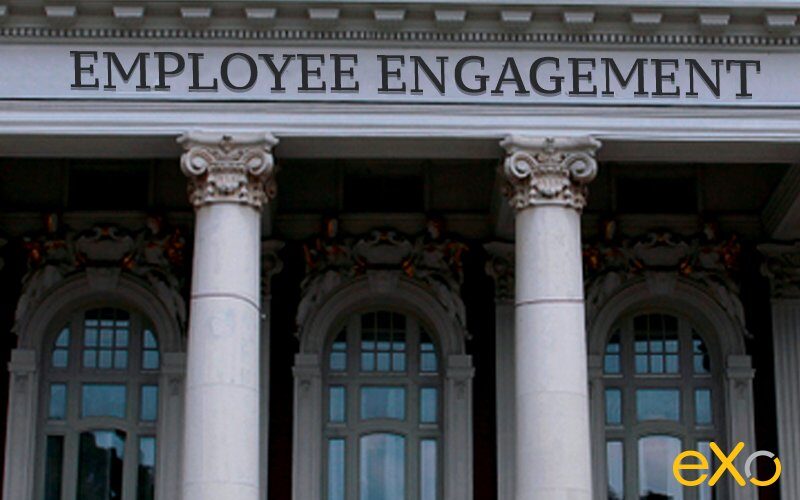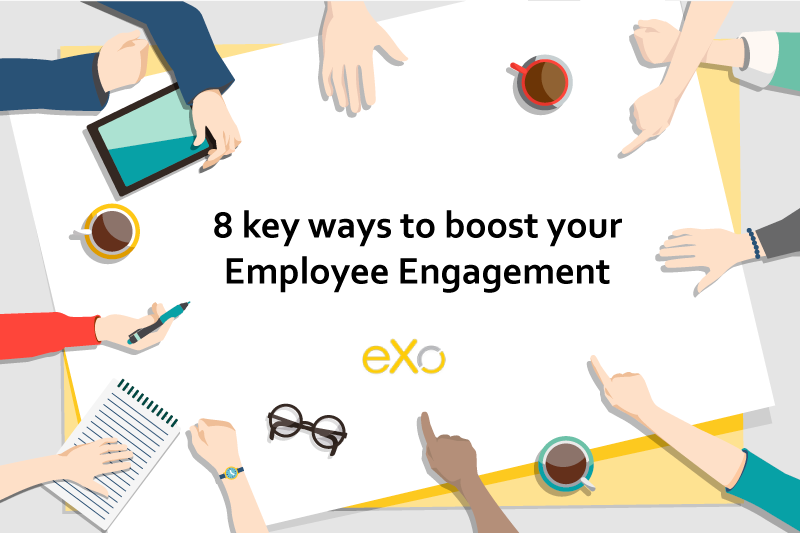- Veronika Mazour
- May 7, 2019
The two pillars of employee engagement - from theory to practice
Now that you are familiar with some useful theories relevant for employee engagement, let us try to put them together into one simple framework to analyse and tackle employee engagement issues.
The two pillars of employee engagement are employee experience and the impulse-reward loop. Both are equally important for employee engagement and both need to be considered together.

Content
If your organisation provides its employees with a compelling employee experience and builds a motivation-reward loop, your employee engagement and your performance will sky-rocket. That sounds straightforward enough. Let’s see how it works.
1. Employee experience - the necessary foundation for employee engagement
Employee experience encompasses everything an employee experiences in relation to the workplace. Starting from the job advertisement in a paper, till the day the employee leaves the company.
While each step of this experience is important, some parts are of course more important than others. For example, the employee only goes through the recruitment process once, but they see their desk and office every day.
Obviously, things that constitute the employee’s daily life are therefore particularly relevant – compensation, workplace environment, the digital workplace, flexibility in office hours, remote work, holiday days, commuting time or atmosphere at work and company culture all contribute to employee satisfaction or dissatisfaction with both the job and the company.
A good employee experience improves employee happiness and satisfaction. While it is not enough to ensure employee engagement, it provides the necessary base for employee engagement to develop.
In the short term, employees can be engaged without being happy, but this does not last. Indeed, such a paradox may arise in the case of a temporary setback when previously satisfied and engaged employees experience a temporary dissatisfaction – construction at the office, a cut in pay due to bad results and similar. Employees can be engaged to redress the situation temporarily but should the dissatisfaction continue, engagement will inevitably plummet.
The only long-term examples to the contrary are witnessed in totalitarian regimes where a generation of workers can be engaged and dissatisfied, working for a greater tomorrow. Such a miracle of persuasion requires lack of information sources, heavy propaganda and other conditions that should not be met in a normal corporate setting.
The easiest way to describe the relationship between employee engagement and employee satisfaction is that of a tree. Employee satisfaction can be seen as the fertile soil upon which a company can grow the tree of employee engagement. Relevant employee experience is the fertiliser that allows the soil to become fertile.

FREE WHITE PAPER
The Complete
Guide to
Employee Engagement
Guide to
Employee Engagement
There are many definitions for the concept of employee engagement out there.
2. The impulse-reward motivation loop - to kick start your employee engagement
Imagine a company where employees are relatively satisfied – they are sufficiently compensated, their workplace is pleasant, they are enabled to do their best through digital tools, the atmosphere is friendly. Overall, all is well. Would those satisfied employees be engaged? Not necessarily. High employee satisfaction will probably ensure that most of your workforce is not actively disengaged, but they can very well remain unengaged.
How do you ensure that those employees do their best, are enthusiastic about their job and invested in their company? By addressing the second pillar of employee engagement – the impulse-reward motivation loop.
The first part of the loop is of course the impulse. Any number of actions can motivate your employees to put a little more energy into their work – working in a team, being offered training to work on particular skills, being personally asked to contribute to a knowledge base on a particular topic, simply being asked by the manager to perform a task. In a nutshell, any event that pushes an employee to do something can constitute an initial impulse and it does not need to be big.
The second part of the loop – the reward – is more important. For any effort and energy that the employee puts into a task, they need to be rewarded in some way. This can be a bonus after successfully completing a big project, or it can be a simple thank-you, congratulations – a public acknowledgement of the employee contribution.
In fact, the more frequent the reward, the more energy the employee puts into their tasks. The dopamine loop is quite addictive. For that reason, splitting a big goal into small steps and rewarding each step reinforces motivation in the long run much more efficiently than a big bonus once a year.
3. Common mistakes when handling employee engagement
At this point, the differences and the relationship between the terms employee experience, employee engagement, satisfaction and happiness should be clear for you. In short, employee experience is a way to address your employee happiness and satisfaction levels and provide a foundation for your employee engagement. Employee engagement, is a more complex issue that requires an impulse-reward system to flourish, provided that the foundation is sound enough.
Focus solely on employee satisfaction
Usually, companies wishing to improve their employee engagement focus solely on employee experience. When executed correctly, this strategy acts on job satisfaction levels but fails to really motivate the employees. Especially since, in modern workplaces, employees increasingly need motivation not only to be engaged but even to be satisfied.
For example, the last SHRM report on employee job satisfaction and engagement mentions the following basic factors among the greatest contributors to job satisfaction: respectful treatment, compensation, trust in management and job security. They are also among the greatest factors that make employees leave their company.
However, in the same report it is interesting to note that motivational factors are ranked increasingly important year after year. For examples, opportunities to use skills were mentioned as being very important by 44% of those surveyed in 2004, and by 58% of those surveyed in 2014.
Equate motivation with compensation
Most companies rely on compensation as a unique reward strategy. In the best case scenario, employees get paid the market rate or above, with regular pay increases based on performance and regular periodic bonuses, also linked to performance. Some sort of review system is used to link compensation/bonus with performance. When companies try to improve their compensation policies they focus on monetary factors (the percent of increase, the amount of bonus) and on the link between compensation and performance (the quality of reviews and such).
The above strategy does nothing to improve motivation. The best it can do is to avoid dissatisfaction. Indeed, when reviews are done periodically, some contributions inevitably get overlooked. The lack of a direct link between contributions and work and compensation is a source of dissatisfaction for a lot of employees. In the best-case scenario, the employee is content but that feeling does not last – as with any emotion it is fleeting. Also, employees tend to consider a certain compensation level (be it salary or bonus) as their due for a certain level of normal performance. Anything less is perceived negatively, but more only increases the level of expectation for “normal” (that is to say good but not exceptional) performance.
To provide a positive reward loop, the reward needs to be easily linked to the contribution and immediate, or at least as close to the action as possible. However, it does not need to be immediately tangible or translated into cash. People feel motivated by a simple expression of recognition, a positive comment from a peer, encouragement from a manager, or a gift.
Discover our solutions for employee communications and engagement
FAQ
You will find here Frequently Asked Questions about employee engagement with all the answers in one place.
What is employee engagement?
It’s the willingness of an employee to help his company progress. It is a positive behavior, which manifests itself by a strong involvement in his work and by a great motivation. This allows the company to evolve both in terms of its activity and on a human level.
How to Improve Employee Engagement in the Workplace?
- Ensure a strong corporate culture
- Ensure good relationship with management
- Foster good relationships between the colleagues
- Think about employee recognition
- Express meaning for work in your organization
- Make well-being and work/life balance your priority
- Allow more flexibility and autonomy
- Invest in skills development and training
➝ Find out how to improve employee engagement in the workplace
4.8/5 - (132 votes)
I am the Chief Executive Officer of eXo Platform (the open source digital workplace platform), a company that I co-founded while in college and that I came back to after several years in the banking and consulting industry. I blog about modern work, about open-source and sovereignty issues. Occasionally, I also blog about my personal areas of interest, such as personal development, work–life balance, sustainability and gender equality.
Related posts
- All
- eXo
- Digital workplace
- Open source
- Internal communication
- Collaboration
- News
- intranet
- Future of work
- workplace
- Knowledge management
- Employee engagement
- Employee experience
- Employee productivity
- onboarding
- Employee recognition
- Change management
- Cartoon
- Digital transformation
- Infographic
- Remote work
- Sneak Peek
- Solutions
- Thought leadership
- Tips & Tricks
- Tutorial
- Uncategorized
Leave a Reply
( Your e-mail address will not be published)
Connexion
0 Comments
Commentaires en ligne
Afficher tous les commentaires


